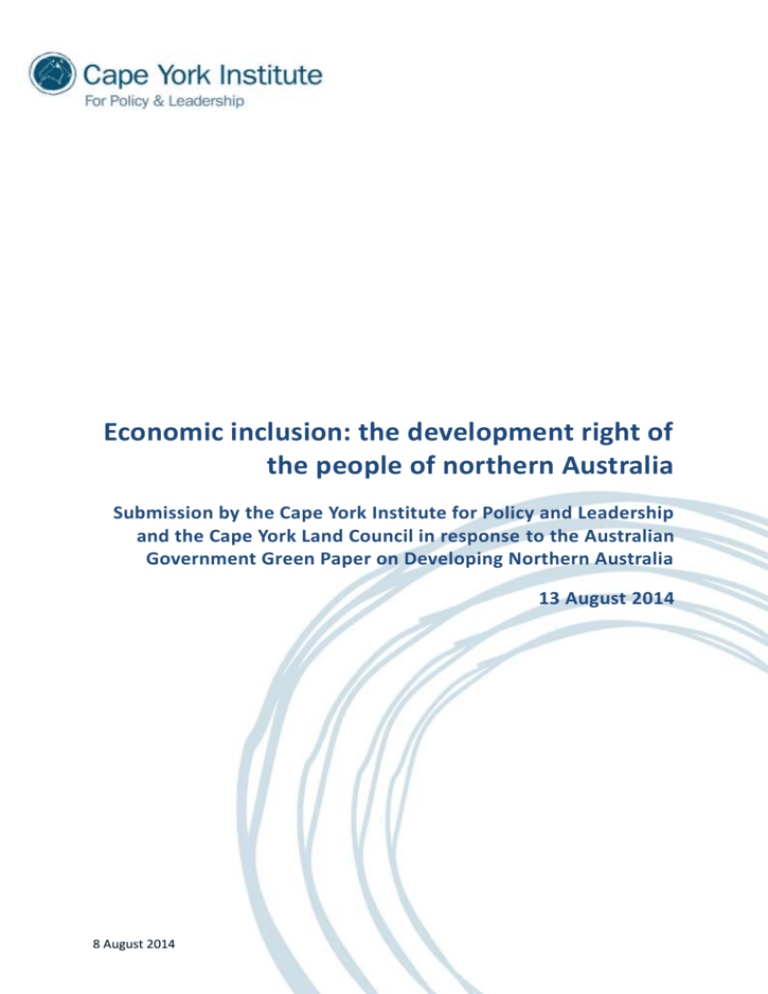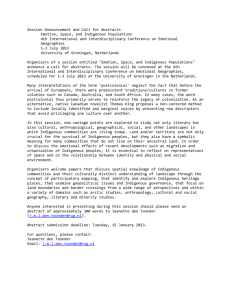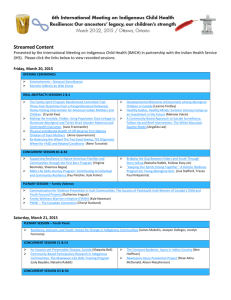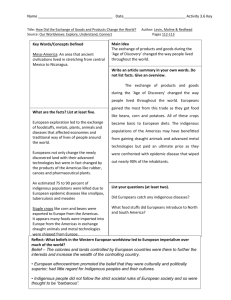DOCX: 1683 KB
advertisement

Economic inclusion: the development right of the people of northern Australia Submission by the Cape York Institute for Policy and Leadership and the Cape York Land Council in response to the Australian Government Green Paper on Developing Northern Australia 13 August 2014 8 August 2014 Contents 1 2 3 4 5 6 7 8 Introduction ............................................................................................................................. 2 Maximising the return from existing infrastructure and services in Cape York Indigenous towns. 2 What new infrastructure is needed to connect Indigenous people to Australia’s economic grid? . 3 Planning and land administration systems are invisible yet essential infrastructure for economic development ............................................................................................................. 3 Increased government investment for the resolution of native title and land tenure .................. 4 The role of resource planning for enabling sustainable development: the need for Cape York catchment-by-catchment land and water resource assessments ................................................ 5 Understanding and tackling the unemployment crisis in Indigenous communities ...................... 6 The role for tax incentives to underpin investment and development ........................................ 6 1 1 Introduction The Indigenous people of Cape York are critical to the future of Northern Australia through their presence and identity, and increasingly through their enterprise, and use of their land. The Cape York Institute pursues a comprehensive development model for Cape York Indigenous people including through Cape York Welfare Reform since 2008, and through the current development of the Empowered Communities reforms. This development framework is a prism by which all government objectives and expenditure should be considered, including an unwavering focus on rebuilding social norms, lifting education outcomes, and engagement with the real economy. If we are to be successful in building a pathway from disadvantage to a sustainable, economically viable future for Indigenous people living in remote and regional areas in Cape York and in northern Australia, there are several specific issues not currently canvassed in the Green Paper that need to be addressed in the White Paper. 1 2 3 4 5 6 7 2 Maximising the economic return from the already very substantial infrastructure and network of services in Indigenous towns. What new infrastructure is needed to connect Indigenous people to Australia’s economic grid? Planning and land administration systems are invisible yet essential infrastructure for economic development. Increased government investment for the resolution of native title and land tenure. The role of resource planning for enabling sustainable development: the need for Cape York catchment-by-catchment land and water resource assessments. Understanding and tackling the unemployment crisis in Indigenous communities. The role for tax incentives to underpin investment and development. Maximising the return from existing infrastructure and services in Cape York Indigenous towns There are 16 Indigenous towns on Cape York with a total population of almost 10 000 Indigenous people including 9 discrete Aboriginal Shire Councils. Each town has a significant inventory of local infrastructure including an urbanised footprint of serviced land (including grid power and water supply) with road and kerbs; health clinics; council offices; airstrips; marine facilities; stormwater, sewage and water treatment; and schools. All residents live in government funded housing. The net sunk cost of existing infrastructure on Cape York is several billion dollars with an annual bill for new infrastructure, repairs and maintenance, and services being several hundred million dollars. For example, it is estimated that the Cape York share of the National Partnership Agreement for Remote Indigenous Housing alone is $70 million per year between 2009-2018 (Land Program Office estimate). It is therefore astounding that this extraordinary pool of infrastructure is not accounted for and incorporated into government policy and planning frameworks for Indigenous economic development, including discussion to date on the Northern Australia White Paper. CYI’s vision for Cape York Indigenous towns is that they are vibrant economic hubs with a range of small and medium enterprises operating with the majority of people owning their own homes. Mobility and orbiting will be an important part of the education and employment story, the same as for any small Australian town. It is critical that policy actions by government match local aspirations, and leverage and create an economic return from the massive ongoing investment in infrastructure and services. Local families deserve this focus and taxpayers demand it. 2 3 What new infrastructure is needed to connect Indigenous people to Australia’s economic grid? If the vision for existing infrastructure is seen within a development context then further questions naturally arise about what new or greenfield infrastructure is required to enable development to takeoff. Necessary new infrastructure covers a spectrum of needs, including new roads and port facilities to help connect towns and people to the mainstream economic grid, and land administration infrastructure and systems long taken for granted by people living in non-Indigenous towns. With regard to roads and ports, it seems absurd that so much money would be spent on building and servicing infrastructure in remote Indigenous towns whereas funding for connecting road and port infrastructure is sporadic and limited by comparison. Again, this focus stems from the de facto model being pursued by government which is far too heavy on social policy provisioning and far too light on addressing the underlying development challenges. CYI asserts that there is a very strong case for investment in roads to connect Cape York Aboriginal towns with major arterial roads such as the Peninsula Development Road (PDR). The funding for connecting roads and connection/arterial roads on Cape York are of an equal priority and must not be seen as an ‘either or’ proposition. For example, some recent discussion about redirecting $210 million of allocated ‘connecting road’ funding to the PDR demonstrates the partial nature of the guiding rationale and current ad hoc planning. There is no dispute that the PDR deserves funding but additional funding also needs to be found and not hypothecated from critical connecting road infrastructure funding for Indigenous towns. Longer term planning must provide a rational plan for work to the PDR and connecting roads to provide better wet season access across Cape York, including to improve wet season access of Indigenous towns to the ‘main infrastructure grid’ as reliably and swiftly as possible. For example, in terms of the current funding envelope of $210 million, it may have been the case that spending some of these funds to provide Kowanyama three months of additional access to the grid through upgrading their connecting road, should be prioritised over spending the $210 million on the PDR if it is still incomplete and a ‘road to nowhere’ in the wet. 4 Planning and land administration systems are invisible yet essential infrastructure for economic development Home ownership and economic development have been a core focus of Welfare Reform for over five years yet the results have been abysmal. There has not been a single home ownership outcome in any Cape York Indigenous town. This is not for a lack of local aspiration. The core problem that always was, and remains, is the lack of enabling tenure and local land administration systems. A functional land administration and tenure system is essential infrastructure that is missing from these towns. To address the historical lack of investment in land administration and other public goods that are part of the development system, there have been some positive investments made by the Queensland Government and administered through the Remote Indigenous Land and Infrastructure Program Office (RILIPO) and through new Queensland legislation to enable the creation of fee simple freehold title in town areas. It is essential that necessary enabling actions are implemented in discrete Indigenous towns in an integrated and compatible manner so that home ownership and economic development have transaction costs in land and property that are comparable with mainstream towns of the same size. For Cape York Aboriginal towns this means: 3 1. Preparation of a functional Sustainable Planning Act 2009 (Qld) compliant planning scheme for the relevant local government area that identify land where economic development would be a suitable land use. The establishment of proper cadastral infrastructure (survey, subdivision and registration of all lots used for a discrete purpose, building code compliance). Resolution of tenure and infrastructure anomalies such as roads off alignment and encroachments. Resolution of informal, contentious and unregistered interests in land, including interests or entitlements created under the Aboriginal and Torres Strait Islander (Land Holding) Act 1985 (Qld). Negotiation of an ILUA to provide simplified processes to authorise the creation of leasehold interests in land where native title exists, and the surrender of native title to enable tenure conversion to freehold. Cultural heritage clearance of land identified for future development. Completion of Aboriginal Land Act 1991 (Qld) land transfer processes, including in a way which ensures all levels of government and other interested parties continue to have access to and secure interest in the land and infrastructure they deliver services from. Tenure conversion to freehold where agreed. Preparation of trustee policies for the lease or sale of communal land and infrastructure to parties of their choice. Establishment of trust accounts to help underwrite home ownership and economic development investments in the short to medium term. Building capacity of the key participants in home ownership and economic development, including local government, trustees, home owners and business operators. 2. 3. 4. 5. 6. 7. 8. 9. 10. 11. The importance of this type of approach is also of critical importance to areas of land surrounding Aboriginal towns where land owned by land trusts and subject to Native Title is the key for creating viable and sustainable enterprises that employ local people. The Cape York Land Council is currently leading the development of a strategic Settlement Framework for proactively resolving land tenure issues so that land is capable of driving development outcomes for Aboriginal people on Cape York. 5 Increased government investment for the resolution of native title and land tenure It has been over twenty years since the High Court’s Mabo decision and the commencement of the Native Title Act 1993 (‘NTA’), and over twenty-five years since the issue of Deed of Grant in Trust (DOGIT) titles in Queensland. The resolution of native title claims for Cape York is about 30 per cent complete and the transfer of Deed of Grant in Trust (DOGIT) titles from Aboriginal Shire Councils (as appointed temporary trustees) to Indigenous land trusts has only been partially completed in a handful of communities with not a single DOGIT town area transferred. The long anticipated DOGIT transfers and settlement of land ownership and rights issues in town areas are necessary to allow the creation of secure and transferable interests over all individual lots of serviced land for home ownership, economic development, community purposes (for example, parks and gardens) and government service provision, including local government. The pace of progress in these areas is unacceptable and will continue to stunt local aspirations for land and enterprise for decades to come if the current approach is maintained. Increased investment is required for both the resolution of claims and transfer of land as well as building and supporting the capacity of Prescribed Bodies Corporate (PBCs) and Land Trusts to manage their portfolio of interests. Investment by government in this area should be seen as an enabling 4 action that is temporary and gradually reduced over time with PBCs and Land Trusts becoming fully independent and self-sustaining in the medium term. 6 The role of resource planning for enabling sustainable development: the need for Cape York catchment-bycatchment land and water resource assessments The current rationale and approach of the Cape York Strategic Environmental Area and Queensland Regional Planning Interests regulation suffers from the same deep flaws as Wild Rivers Declarations and the ex-draft Cape York Regional Plan zoning system. As for Wild Rivers and the ex-draft Cape York Regional Plan, Aboriginal people are still the only ones to lose and the gap between the Indigenous development rhetoric of the Queensland Premier and Deputy Premier and the policy reality appears as wide as ever. Aboriginal freehold and DOGIT land tenures place few restrictions on land use—indeed the same bundle of private property rights exists as for holders of fee simple freehold title (although Aboriginal freehold and DOGIT are communally held tenures). As such, Indigenous landholders can conduct activities including construction, farming, horticultural activities and tourism enterprises on their land (subject to existing laws, including environmental protections). However, attempts to impose special environmental regulatory and planning measures on Cape York – including Wild Rivers declarations and zoning of Strategic Environmental Areas—treats Indigenous land (Aboriginal freehold, DOGIT or Reserve land) as if it were public land. Capture of such land within such schemes has the effect of restricting the private land use rights of Indigenous landholders in the interests of the ‘public good’, and makes landholders responsible for the management of specific environmental values that are subject to external threats. There has been no consent sought from Indigenous landholders to modify or restrict their land use rights, and no process to support the active management of environmental values that is expected under the regulatory and planning measures. The current special environmental regulatory and planning measures over private Indigenous land on Cape York is at odds with the work being conducted through Cape York Welfare Reform, the Forrest Review of Indigenous Employment and Training, the Australian Government’s Northern Australia Green Paper, as well as the Queensland Government’s Indigenous Economic Participation Framework. The Queensland Government Indigenous Economic Participation Framework states the State will work to link emerging economic opportunities in the resources, tourism and agriculture sectors to ensure greater employment opportunities for Indigenous communities. For example, the Queensland Government is currently seeking to impose a “Cape York Strategic Environmental Area” via a Regional Planning Interests regulation, meaning that opportunities on private Aboriginal land for broadacre cropping and other uses will be restricted. Even a simple desktop assessment of the agricultural potential of Cape York using the Australian Government and Queensland Government mapping resources shows that the current “Cape York Strategic Environmental Area” has significant agricultural potential and water resources within its boundaries, yet no there has been no visible or public process to justify or account for the current exclusion of these values. In stark contrast, the CSIRO-led Report Flinders and Gilbert River Agricultural Resource Assessment (FGARA) report released in early 2014 provides an excellent suite of information for planning and decision-making by landholders and government in adjacent catchments. The Queensland Government has already used this report to grant six new water licences in these two catchments. 5 There must be an end to the zero-sum game approach so evident in Wild Rivers, the ex-draft Cape York Regional Plan and the current Regional Planning Interests regulation. The focus must be on identifying the economic potential and attracting external investment to Cape York within a sustainable development framework. A comprehensive strategy by the Queensland and Australian Governments on resource assessment and planning for Cape York and other areas in northern Australia is essential. 7 Understanding and tackling the unemployment crisis in Indigenous communities The recently released Forrest Review has once again highlighted the unemployment crisis affecting Indigenous people living on Indigenous land with real rates of unemployment approaching up to 80 per cent for young jobseekers (Forrest Review of Indigenous Training and Employment 2014). It is critical that the White Paper on Developing Northern Australia develops an accurate baseline of the extent of the unemployment and underdevelopment problem facing Indigenous people living on Indigenous land. For example, official unemployment data for remote communities masks both the level of the unemployment and underemployment given that work-for-the-dole equivalent activities are measured as an employment outcome. The number of Indigenous unemployed and jobseekers on Cape York far outstrips the number of jobs that are available locally with many local jobseekers either unskilled or semi-skilled. Let’s take Coen and Aurukun as examples: In Aurukun, the vast majority of the total population of 1300 is welfare dependent, and there are about 360 registered jobseekers. In Coen, the majority of the total population of 264 is welfare dependent, and there are about 61 registered jobseekers. Not only are the majority of Indigenous residents in Aurukun and Coen long term welfare-dependent, the local ‘economy’ in each place continues to be almost entirely sustained through the transfer of government funds. All residents in Aurukun, and all Indigenous residents in Coen, live in governmentfunded social housing. It is not yet possible in Aurukun for people to own their own home due to land tenure issues, and in Coen there are concerns that valuations are being set too high by government for sale of social housing. To date, there have been no home ownership outcomes. The jobs that do exist are mostly skilled service sector jobs, and they are generally filled by non-Indigenous people. Cape York’s Indigenous people cannot build an economic future based on a simplistic, almost monoculture economic base (an eco-economy base or utopian eco-tourism vision). Everywhere in Australia, the need for a diverse economy is paramount. Indeed, governments spend much time and effort in the pursuit of this. They do so because it is vital to not depend on a single or small number of economic activities. Enabling the long term social and economic viability of Cape York and other remote areas will necessarily involve expanding and diversifying the region’s economic base, and reducing reliance on government support as well programs that support orbiting and mobility for work and employment. 8 The role for tax incentives to underpin investment and development Tax incentives are an important area for the Australian Government to consider as part of a multifaceted and long term strategy to drive individual choice and economic viability and 6 independence from government transfers for Indigenous Australians, particularly for people living on Indigenous land. What is most needed is more debt and equity investment in Indigenous businesses and access to private sector expertise. The Cape York Partnership is endeavouring to pursue a model on Cape York that gives clear preference to financing and owning a share of a business and to benefit from the natural relationship and discipline of financing and caring about the growth and success of a business. The Forrest Review has raised the idea of giving Indigenous businesses a tax exempt status. From our perspective on Cape York, we believe that it is important to understand that tax exempt status only helps profitable companies – this is not going to assist start-up/early stage companies investing in technology and incurring losses. In this regard, a rebate against operating losses to insulate against downside risks may be more appropriate. Given that many Indigenous communities are remote, do not have a deep skills base, lack infrastructure, lack a supplier network or other commercial ecosystem, it may be appropriate to provide a higher loading/rebate to companies located in these regions. This would in effect help get Indigenous enterprises to par versus more traditional enterprises in cities that do not face those challenges. The reality is it is just harder to do business in these places. The Forrest Review also raised the idea of mandating a minimum public procurement level for Indigenous businesses. While encouraging the growth of Indigenous businesses through tax treatment would be an important initiative, legislating that a revenue line should exist does not build entrepreneurial or operational capacity, which is critical. A lot of money has been wasted by the public sector trying to build capacity on this front. This task is beyond the skill set of government. Neither Indigenous Business Australia (IBC) nor the Indigenous Land Corporation (ILC) has had success in this regard. The natural ‘capacity builder’ is the private sector. There is an opportunity for tax incentives or similar measures to attract the capacity and capital of big corporates. Incentives should exist to encourage private capital to invest in Indigenous businesses. If private or institutional capital (such as from the private equity or venture capital sectors) invested they would be highly incentivised (for return on capital and reputational reasons) to build the capacity of the Indigenous operators. Tax incentives for such investment, potentially structured along the same lines as the R&D Tax Incentive, are one potential device. A tax refund program such as the current R&D refundable benefit program is much more appropriate than exempt status or a grant, as it ensures ‘skin in the game’, encourages considered investment, cost control, and provides cash benefit which incentivises investment and reduces risk by effectively reducing the cost of investment required to fund startup/investment opportunities. An extension of this would be to apply a higher percentage rebate to particular cost lines e.g. Indigenous employment costs which is in a sense an offset against social support. There is also an important role for tax incentives tied to land reform. For example, conditional tax concessions in such areas could be tied to fundamental reforms supporting local economic development, such as enabling private business development and property ownership. Given the importance of social norms in explaining welfare dependence, it would seem sensible to seek changes to the remote environment in which Indigenous families live through fundamental reforms to local economic systems. 7






